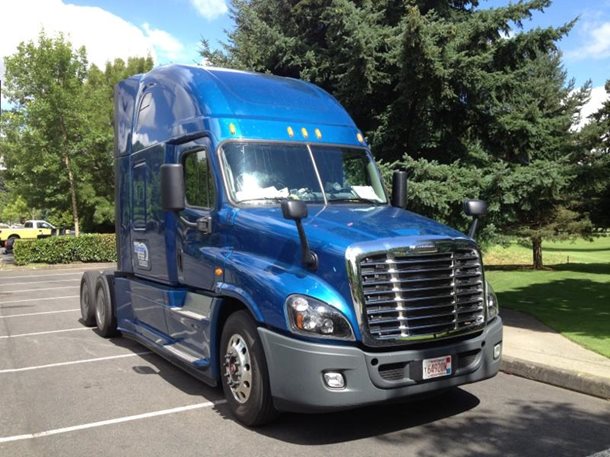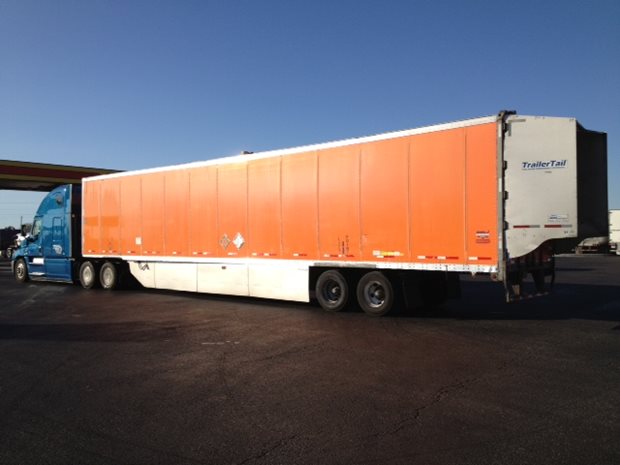Today's blog will feature my guest , Jim Bauman . I met Jim on Facebook quite some time ago and he was interested in the Cascadia Evolution . After we discussed my truck's specifications and fuel mileage results, Jim decided to order a clone of my 2013 Cascadia Evolution . I asked Jim if he would like to write about his experience with his new 2014 Cascadia Evolution . I hope you enjoy Jim's story .

We could not be happier with our 2015 Cascadia Evolution. I knew that emissions compliance hurt fuel economy when first required back in 2003, and I wasn't sure that the new, emission compliant engines could match the fuel economy of our old 2002 Freightliner Century. Henry Albert was extremely patient with me, as I contacted him more than several times, asking about spec's and fuel milage. He was posting numbers in the high 9's and low 10's, but I was somewhat skeptical about his numbers for two reasons: his loads were always relatively lighter than ours (we're used to having 42K lb loads in our trailer), and also, Freightliner provides his truck (no truck payment ever!) where Henry in exchange presents his experience and facts about the truck and how it performs to potential customers like me . Nothing against Henry; I very much like and respect him, but after all, I could see someone in his position having a potential to tweak the numbers to make the Cascadia appear more favorable! I was shocked to realize that the last ten fuel-ups with our new Evolution yielded an average of 9.05mpg! Every one of the loads had between 22,000 lbs in the trailer and 32,000 (GVW between 58,000 and 68,000 lbs), and a cruise speed of 63mph. Even with heavy 42K lb loads going into the trailer (gross 78K lbs), the truck consistently obtains around 8.46 mpg. Our old 2002 Century couldn't touch these excellent numbers; so the new Evolution not only matched our old Century's economy, it is doing considerably better! To this day, I'm still delighted and almost shocked.

Excellent fuel economy is the top reason I love this new tractor, since this allows us to convert more of our gross pay to net pay. The second noticeable improvement is the quietness. Diesel clatter and turbo whine very very noticeable in our old tractor, and both are noticeably absent in this new Cascadia. I think this will help protect my hearing; a quieter running truck also means the radio doesn't have to be turned up high to overcome ambient noise. It might seem strange to rank "quietness" so high on the list, but when we're in a truck for so long, this factor makes a huge difference in improving quality of life behind the wheel.
Another awesome feature is the Park Smart (battery powered A/C and diesel fired heater). We were delayed in Houston, Tx for over 10 hours, when it was 95 degrees outside. Surprisingly, the Park Smart kept us cool the whole ten hours, without having to idle. What allows such a long duration is the four extra AGM batteries, and the extreme insulation package; even the sleeper curtain is insulated, like a flannel shirt, but much thicker. With our old Century, the passenger side floor would get extremely hot, due to the exhaust pipe underneath it. This is not the case with this Cascadia; the floor remains cool, even during a hard pull during the summer.
The DT12 automated, direct drive transmission is yet another positive impression. I had driven some automated transmissions previously, and I did not like the way they shifted; even with a light load, they would run the engine rpm's very high before shifting to a higher gear, which is not good for fuel economy. This DT12 is nothing like the automated transmissions of yesterday; it is incredibly sophisticated. Under light loads, the shift points occur at much lower rpms; and if possible, the transmission will even skip gears, which further increases fuel economy. Part of what helps this Evolution's fuel economy is the "E-coast" function of the DT12. With E coast, the transmission will effectively go into "neutral" while going down gentle grades, which means you'll coast much further. I was surprised that in certain areas, I would literally coast for over a mile, all the while the engine is just idling at 600 rpm!
The last feature I'll mention is that the truck is a 6X2, meaning that only one of the tandem axles is powered. Therefore, 6X2's have no power divider, nor do they have any gears in the other tandem axle; this results in greater efficiency. In talking with Henry Albert, who obtains remarkable fuel milage with his 6X2 Evolution, I was convinced to do the same. I believe that 6X2's save about .3mpg over 6X4's, half of this coming from the eliminated gears, and the other half coming from the fact that now one can use trailer tires on the non-drive "tag" axle. Trailer tires have far less rolling resistance than driver tires, or even steer tires. I was worried about the traction of 6X2, since now we have only one powered axle. When we first took delivery of our new Evolution 6X2 this past March, we had a trip from Charlotte, NC to Seattle, Wa. On I-90, there is a steep grade going west as you cross from Idaho into Montana. There had been a snowstorm that caught the DOT off guard, where the grade was not plowed or treated with chemicals, nor was the "chain-up" sign turned on. Several 6X4's had gotten stuck, and we were able to make it almost to the top, but another truck in front of us got stuck and blocked the roads. Soon the plows came by, and I was able to get going again merely by chaining the outer wheels of our live axle. I was pleased that, after all, our 6X2 performed as well as 6X4's; better yet, passed several 6X4's already stuck. To be fair, we had a heavy load, where this weight over the drive axle is a definite advantage. Bottom line, the 6X2 is not nearly as disadvantaged as I thought it might be in such conditions. Keep in mind that our 6X2 has a locking differential, as well as a suspension system that automatically dumps air from the non-powerd axle when wheel spin is detected via ABS system. This allows more weight to be transferred to the live axle; yielding improved traction. One difference between our 6X2 and Henry's, we have dual fuel efficient tires, where Henry has wide single efficient tires. As dual tires have become almost as efficient as wide singles (due to competition), I feel that the extra traction they provide is reassuring, particularly on a 6X2's drive axle, especially when there is no longer an noticeable fuel efficiency difference.
If anyone would like to contact me with questions about our 6X2 Evolution, call me at 704-918-7759. I get zero perks from Freightliner to provide this feedback, but I'm so happy with ours that I'd love to help other potential buyers, as I know how much stress spec'ing a truck can be; you want to get it perfect!
-Jim Bauman
